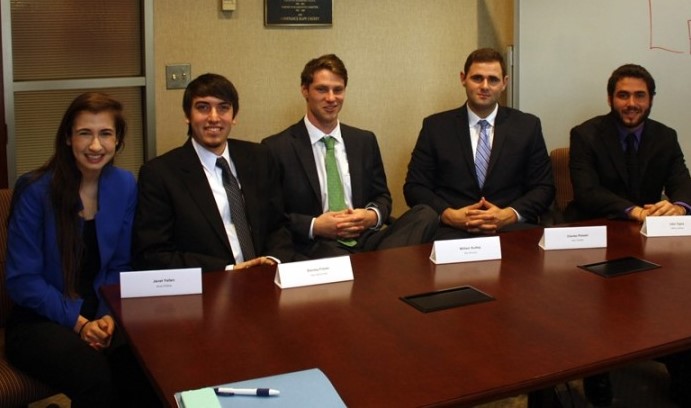A more personal understanding of the Federal Reserve

Lehigh students and their alter egos competed in the College Fed Challenge on November 14: Anna D’Ginto ‘16 (Janet Yellen), Alec McConnell ‘16 (Stanley Fischer), Mac McGuire ‘15 (William Dudley), Alex Connery ‘16 (Charles Plosser), and Jeffrey Liebman ‘16 (John Taylor).
On Friday, Nov. 14, economist John Taylor squared off in an unusual debate about U.S. economic policy with Janet Yellen, chair of the Board of Governors of the U.S. Federal Reserve System; Stanley Fischer, vice chair of the Fed; William Dudley, president of the Federal Reserve Bank of New York and vice-chairman of the Federal Open Market Committee; and Charles Plosser, president of the Federal Reserve Bank of Philadelphia.
If these public figures didn’t look quite like themselves, it was because they were being played by five Lehigh students participating in the College Fed Challenge competition. Anna D’Ginto ‘16, Alec McConnell ‘16, Mac McGuire ‘15, Alex Connery ‘16, and Jeffrey Liebman ‘16 took on the different roles during their presentation at the Philadelphia Reserve Bank District regional competition, which was held at Lafayette College.
The Federal Reserve is the central banking system of the United States, and it is responsible for balancing the U.S. economy. The Federal Open Market Committee (FOMC) meets every six weeks to review the economy and discuss financial policies. It make decisions about what to do with the federal funds rate, which influences all other interest rates in the economy, while also deciding on nonconventional monetary policy actions.
The College Fed Challenge invites students to replicate what goes on in a FOMC meeting. Students analyze the economy, build a model, and advise how the Federal Reserve should act based on that model. They do so in the form of a 15-minute skit, allowing for some creativity—as well as the appearance of sometimes unlikely characters. The skit is followed by a 15-minute Q and A session. A panel of judges scores each team for economic analysis, responses to judges’ questions, teamwork, and presentation.
Students had to apply to join Lehigh’s Fed Challenge team, which prepared for the competition in a three-credit special topics course taught this fall by Alex Nikolsko-Rzhevskyy, assistant professor of economics. The class met biweekly, but the team’s five presenters met more frequently.
Jasmine Ameerally ‘15, Courtney Patterson ‘16 , Savannah Monser-Kernosh ‘15, Simon Wong ‘15, and Gregory Oprea ‘15 served as researchers, helping develop the team’s presentation. The five presenters reviewed the presentation’s content meticulously to ensure the confident and natural delivery of their skit. After months of hard work, they were ready to compete.
Opting for rules over discretion
Though prior coursework proved helpful, the students had to push themselves. “Even if you came in with A’s in all of those courses, you’d still need to learn so much,” said McGuire, who portrayed William Dudley.
“We learned a lot from the process,” said D’Ginto, who played the part of Janet Yellen.
Although the team did not emerge victorious, their preparation included a real-life rehearsal. Before the Philadelphia Reserve Bank District competition, students gave mock presentations at Barclays Investment Bank and at Market News International in New York, where economists advised them on how to strengthen their argument.
“Alex Nikolsko-Rzhevskyy is an outstanding coach and our Lehigh alumni and friends are instrumental in assisting the team,” said Jim Dearden, professor and chair of economics. “Each year, Mike Connor ‘80, founder and chief executive of Market News International, and Larry Kantor, former Lehigh economics professor and head of research for Barclays, host the team for their New York practice day and offer invaluable feedback and advice.”
The Lehigh team utilized extensive technical knowledge in their presentation and explained alternative tools the Federal Reserve could use to increase interest rates rather than the traditional method of open-market operation. The students gave conclusions, discussed possible risks, and addressed how those risks might be handled.
After weighing the pros and cons of using rules rather than discretion to set the federal funds rate, the team decided in favor of the Taylor Rule, an interest rate-setting model named for its creator, John Taylor, who was played by Liebman.
“We wanted to push for a radical change in how monetary policy is conducted,” said McConnell, who played the role of Stanley Fischer.
The hands-on learning experience proved priceless to students, providing them with a glimpse into the making of economic policy.
“In a lot of classes you’re presented with these ideal scenarios. In the real world, it doesn’t work like that,” said McConnell. “[At] every turn we made, we were faced with a different challenge in something we hadn’t been exposed to before.”
“It’s a great introduction to just how truly hard it is to get a grasp of what’s going on in the world economy and then to make a decision off that, let alone understand it,” said McGuire.
“It’s an exciting time for the Fed, and we got to be a part of that,” said D’Ginto.
“I think if there’s anything I took away from this, it’s that the economy is more than just graphs and relationships,” said McConnell.
“Year after year, our Fed Challenge team competes at high level,” said Dearden. “The hard work of the team members pays off not only in terms of the competition itself, but also in the insights they gain about monetary economics and the jobs they land as a result. Their successes—the high ratings from the competition’s judges—are a team effort.”
This year’s Philadelphia Reserve Bank District regional competition of the College Fed Challenge was won by Princeton University.
Story by Kelly Hochbein
Posted on:

